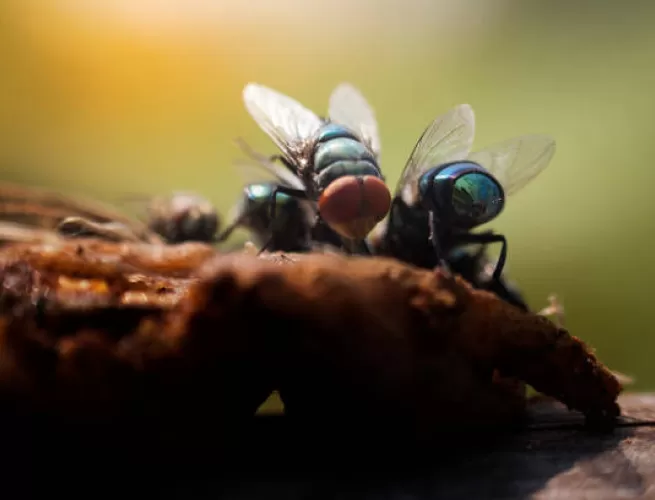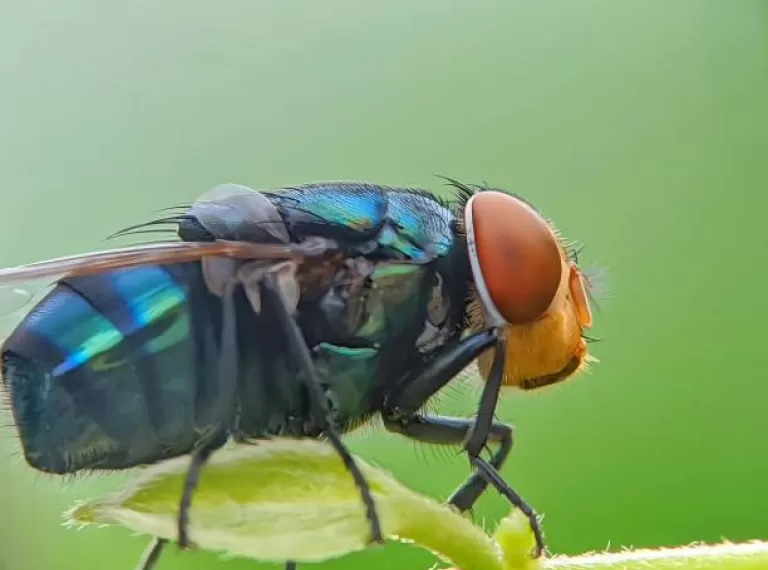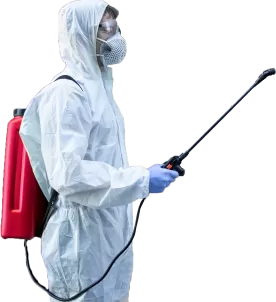Best Flies Control Services from Aardwolf Pestkare
If you’re struggling with a fly infestation in your home or business in Singapore, look no further than our Aardwolf Pestkare’s fly pest control services. Our team of experts are equipped with the knowledge and tools necessary to effectively eliminate flies from your property.
We understand that flies can be a major nuisance and can pose health risks, especially when they are present in areas where food is prepared or consumed. That’s why we take a comprehensive approach to fly pest control, starting with a thorough inspection of your property to identify the root cause of the infestation.
Our pest control professionals will then develop a customized treatment plan that is tailored to your specific needs. We use safe and effective methods to eradicate flies, including targeted baiting and trapping, as well as environmentally-friendly insecticides.


Identifying Flies
The most common Fly species in Singapore are :
- House Fly (Musca domestica)
- Flesh Fly (Sarcophaga spp.)
- Blow or Bottle Fly (Calliphora spp., Pharnicia sericata)
- Sewer Fly (Psychoda spp.)
- Fruit Fly (Drosophila spp.)
- Phorid Fly (Megaselia spp.)
- Sphaerocerid or Small Dung Fly (Leptocera spp.)
You can distinguish the different fly species by observing their colour, eyes, size, and even where they tend to congregate. Flies can transmit diseases like cholera, typhoid, diarrhoea, dysentery and salmonellosis.
How do you know you have fly infestation?
Identifying a fly infestation in your property is essential to taking prompt action and preventing the problem from escalating. There are several signs to look out for that may indicate the presence of a fly infestation. Here are some key indicators:
Sightings of Flies:
The most obvious sign of a fly infestation is the presence of a large number of flies in your property. This could include houseflies, fruit flies, drain flies, or other species of flies.
Fly Larvae or Pupae:
Fly larvae (maggots) and pupae are often found in areas where flies lay their eggs, such as garbage cans, compost piles, or drains. These may look like small, white, worm-like creatures or small, brown capsules.
Unpleasant Odor:
Large fly infestations can produce an unpleasant odor due to the presence of decaying matter. This odor may be particularly noticeable near garbage cans, drains, or areas where food is stored or prepared.
Sticky or Greasy Surfaces:
Flies leave behind droppings and regurgitated material that can create sticky or greasy surfaces. You may notice these on windowsills, countertops, or other surfaces where flies have been active.
Bite Marks:
Some species of flies, such as biting flies, can leave behind bite marks on humans or animals. These bites may appear as red, itchy welts.
If you suspect a fly infestation in your property, it’s essential to take action as soon as possible. Contacting a pest control professional can help you identify the type of fly and the extent of the infestation, as well as develop a customized treatment plan to eliminate the pests and prevent them from returning.

Booklice

Heavy Infestation By Booklice

How to prevent fly infestations?
Check out our blog: 5 Secret Cockroach hideout in your house.
Identify entry points and hiding places. Inspection is a crucial step in locating cockroach access points and hiding locations. Because cockroaches are nocturnal insects, it is advisable to do an examination at night.
Their probable access locations include cracks, fissures, or gaps developed around utility lines and pipelines. To seal the access locations discovered, silicone-based caulk might be utilized. Also, examine, clean, and ventilate the spaces beneath the kitchen sink and refrigerator, since these are the moist locations that can become cockroach breeding grounds.
Identify entry points and hiding places. Inspection is a crucial step in locating cockroach access points and hiding locations. Because cockroaches are nocturnal insects, it is advisable to do an examination at night.
Their probable access locations include cracks, fissures, or gaps developed around utility lines and pipelines. To seal the access locations discovered, silicone-based caulk might be utilized. Also, examine, clean, and ventilate the spaces beneath the kitchen sink and refrigerator, since these are the moist locations that can become cockroach breeding grounds.
Identify entry points and hiding places. Inspection is a crucial step in locating cockroach access points and hiding locations. Because cockroaches are nocturnal insects, it is advisable to do an examination at night.
Their probable access locations include cracks, fissures, or gaps developed around utility lines and pipelines. To seal the access locations discovered, silicone-based caulk might be utilized. Also, examine, clean, and ventilate the spaces beneath the kitchen sink and refrigerator, since these are the moist locations that can become cockroach breeding grounds.
Identify entry points and hiding places. Inspection is a crucial step in locating cockroach access points and hiding locations. Because cockroaches are nocturnal insects, it is advisable to do an examination at night.
Their probable access locations include cracks, fissures, or gaps developed around utility lines and pipelines. To seal the access locations discovered, silicone-based caulk might be utilized. Also, examine, clean, and ventilate the spaces beneath the kitchen sink and refrigerator, since these are the moist locations that can become cockroach breeding grounds.
Identify entry points and hiding places. Inspection is a crucial step in locating cockroach access points and hiding locations. Because cockroaches are nocturnal insects, it is advisable to do an examination at night.
Their probable access locations include cracks, fissures, or gaps developed around utility lines and pipelines. To seal the access locations discovered, silicone-based caulk might be utilized. Also, examine, clean, and ventilate the spaces beneath the kitchen sink and refrigerator, since these are the moist locations that can become cockroach breeding grounds.
Identify entry points and hiding places. Inspection is a crucial step in locating cockroach access points and hiding locations. Because cockroaches are nocturnal insects, it is advisable to do an examination at night.
Their probable access locations include cracks, fissures, or gaps developed around utility lines and pipelines. To seal the access locations discovered, silicone-based caulk might be utilized. Also, examine, clean, and ventilate the spaces beneath the kitchen sink and refrigerator, since these are the moist locations that can become cockroach breeding grounds.
By following these preventative measures, you can reduce the chances of a fly infestation in your property. However, if you do notice signs of a fly infestation, it’s essential to contact a pest control professional to identify the type of fly and the extent of the infestation and develop a customized treatment plan to eliminate the pests and prevent them from returning.
Suspect a fly infestation in your premises?
Don’t waste time. Get in touch with the best pest control service provider in Singapore now.

Our Fly Control Services
As a professional pest control company specializing in fly pest control, we provide a variety of services to help eliminate and prevent fly infestations. Here are some of the types of fly pest control services we offer:
Inspection and Identification: Our trained technicians will inspect your property to identify the type of fly and the extent of the infestation. This information is used to develop a customized treatment plan to eliminate the pests and prevent them from returning.
Fly Traps and Baits: We use a variety of fly traps and baits to lure and eliminate flies. These traps and baits are strategically placed in areas where flies are most active, such as near garbage cans, drains, or food preparation areas.
Chemical Sprays and Dusts: We use safe and effective chemical sprays and dusts to eliminate flies in areas where traps and baits may not be effective. These chemicals are applied by our trained technicians and are designed to target specific types of flies while minimizing harm to humans and pets.
Ultraviolet (UV) Light Traps: UV light traps are another effective method for eliminating flies. These traps use UV light to attract flies, which are then trapped and killed. UV light traps are especially effective in commercial kitchens or other food preparation areas.
Drain Cleaning: As mentioned earlier, flies often lay their eggs in drains. Our technicians use specialized equipment to clean and sanitize drains, eliminating the breeding grounds for flies and preventing future infestations.
At Aardwolf Pestkare, we take a comprehensive approach to fly pest control, combining a range of methods and techniques to eliminate and prevent fly infestations. Our trained technicians have the expertise and experience necessary to develop a customized treatment plan to suit your specific needs and ensure a fly-free environment.
